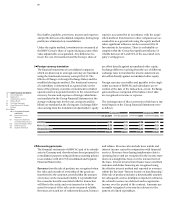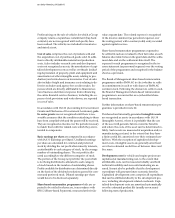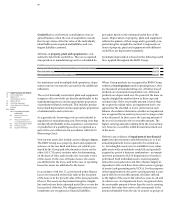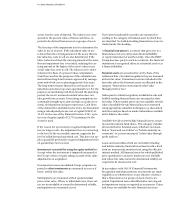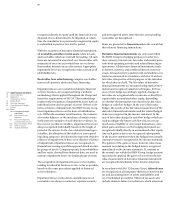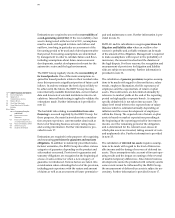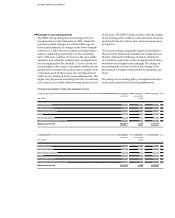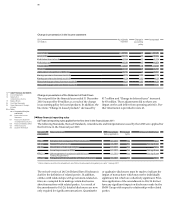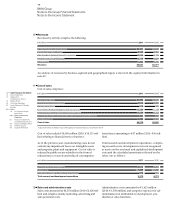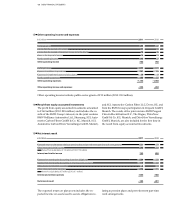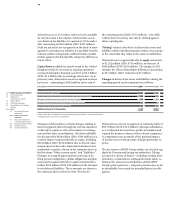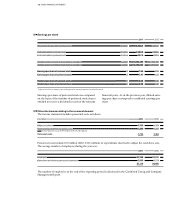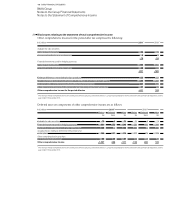BMW 2011 Annual Report Download - page 98
Download and view the complete annual report
Please find page 98 of the 2011 BMW annual report below. You can navigate through the pages in the report by either clicking on the pages listed below, or by using the keyword search tool below to find specific information within the annual report.
98
76 GROUP FINANCIAL STATEMENTS
76 Income Statements
76 Statement of
Comprehensive Income
78 Balance Sheets
80 Cash Flow Statements
82 Group Statement of Changes
in Equity
84 Notes
84 Accounting Principles
and Policies
100 Notes to the Income
Statement
107 Notes to the Statement
of Comprehensive Income
108
Notes to the Balance Sheet
129 Other Disclosures
145 Segment Information
In November 2009 the IASB issued IFRS 9 (Financial
Instruments: Disclosures) as the first part of its project
to change the accounting treatment for financial instru-
ments. This Standard marks the first phase of the three-
phase project to replace the existing IAS 39 (Financial
Instruments: Recognition and Measurement). The first
phase deals with financial assets. IFRS 9 amends the
recognition and measurement requirements for finan-
cial assets and various hybrid contracts. It applies a uni-
form approach to accounting for a financial asset either
at amortised cost or fair value and replaces the various
rules contained in IAS 39. Under the new rules, there
will only be two, instead of four, measurement categories
for financial instruments recognised on the assets side
of the balance sheet. The new categorisation is based
partly on the entity’s business model and partly on
the contractual cash flow characteristics of the financial
assets.
In October 2010 the IASB issued an addition to IFRS 9
(Financial
Instruments: Disclosures) for financial lia-
bilities accounting.
The requirements for financial lia-
bilities contained in IAS 39 remain unchanged with
the exception of new requirements relating to an en-
tity’s own credit when it exercises the fair value option.
IFRS 9 is man datory for financial years beginning on
or after 1 January 2015. The BMW Group did not apply
IFRS 9 early for the financial year 2011. The impact of
adoption of the Standard on the Group Financial State-
ments is currently being assessed.
In May 2011 the IASB issued three new Standards –
IFRS 10 (Consolidated Financial Statements), IFRS 11
(Joint Arrangements), IFRS 12 (Disclosure of Interests
in Other Entities) as well as amendments to IAS 27
(Consolidated and Separate Financial Statements) and
IAS 28 (Investments in Associates), all relating to the
accounting treatment of different aspects of relationships
between entities. The Standards are mandatory for the
first time for annual periods beginning on or after 1 Jan-
uary 2013. Early adoption is permitted. The new Stand-
ards are required to be applied retrospectively.
IFRS 10 replaces the consolidation guidelines contained
in IAS 27 and SIC-12 (Consolidation – Special Purpose
Entities). The requirements for separate financial state-
ments remain unchanged in the revised version of
IAS 27 (Separate Financial Statements).
IFRS 10 introduces a uniform model which establishes
control as the basis for consolidation – control of a sub-
sidiary entity by a parent entity – and which can be
applied to all entities. The control concept must there-
fore be applied both to parent-subsidiary relationships
based on voting rights as well as to parent-subsidiary
relationships arising from other contractual arrange-
ments. Under the control concept established in
IFRS 10, an investor controls another entity when it is
exposed to or has rights to variable returns from its
involvement with the investee and has the ability to af-
fect those returns through its power over the investee.
IFRS 11 supersedes IAS 31 (Interests in Joint Ventures)
and SIC-13 (Jointly Controlled Entities – Non-Monetary
Contributions by Ventures). IFRS 11 sets out the re-
quirements for accounting for joint arrangements, fo-
cussing on the rights and obligations that arise from the
arrangements rather than on their legal form. IFRS 11
distinguishes between two types of joint arrangements,
namely joint operations and joint ventures, and there-
fore results in a change in the classification of joint
arrangements. A joint operation is a joint arrangement
whereby the parties that have joint control of the ar-
rangement have rights to the assets, and obligations
for the liabilities, relating to the arrangement. A joint
venture is a joint arrangement whereby the parties that
have joint control of the arrangement have rights to
the
net assets of the arrangement. IFRS 11 requires joint
operators to account for their share of assets and liabili-
ties in the joint operation (and their share of income
and expenses). Joint venturers are required to account
for their investment using the equity method. The with-
drawal of IAS 31 means the removal of proportionate
consolidation. The equity method is required to be ap-
plied in accordance with revised IAS 28 (Investments in
Associates and Joint Ventures).
IFRS 12 (Disclosure of Interests in Other Entities) sets
out the requirements for disclosures relating to all types
on interests in other entities, including joint arrange-
ments, associated entities, structured entities and un-
consolidated entities.
BMW Group is currently investigating the impact on
the Group Financial Statements of applying IFRS 10,
IFRS 11, IFRS 12, IAS 27 and IAS 28. The removal of
proportionate consolidation is not expected to have a


